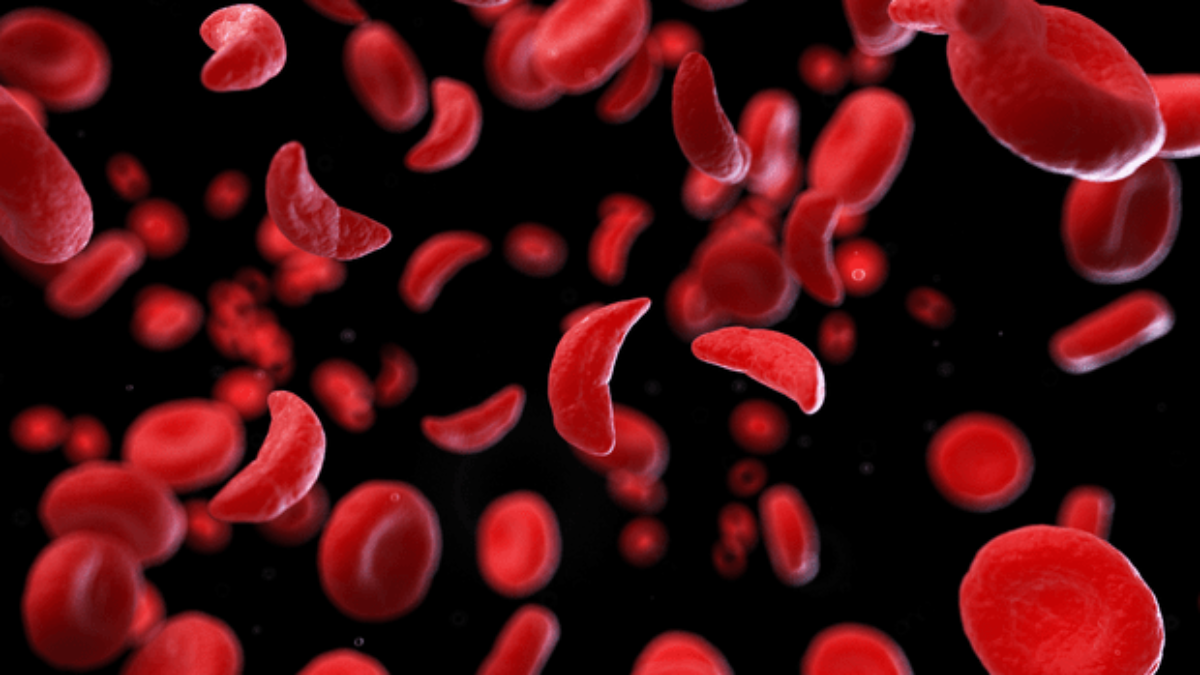Sickle Cell Day (SCD) affects more than 20 million people worldwide which makes it a matter that needs more awareness and education among people. World Sickle Cell Awareness Day is celebrated every year on 19th of June to create public awareness about the disease and spread knowledge on treatment modes to patients.
The most prevalent type of inherited blood disorder Sickle cell disease (SCD) causes aberrant hemoglobin production and is apparent at birth in affected persons. The hemoglobin protein, which is found inside red blood cells, normally binds to oxygen in the lungs and transports it throughout the body. Healthy red blood cells are pliable, allowing them to pass through even the tiniest blood channels.
The defective Haemoglobin in sickle cell disease makes red blood cells hard and formed like a “C” or sickle, the shape from which the disease gets its name. These cells are stiff and difficult to move, and they might obstruct blood flow to the rest of your body. This can cause pains as well as organ damage. Another issue that a person suffering from sickle cell disorder suffers is anemia. As compared to normal red blood cells that live for 90 to 120 days, sickle cells live only for 10 to 20 days. This makes it nearly impossible for the body to replenish the red blood cells in time. This leads to a lack of hemoglobin in the body causing anemia.
What causes Sickle Cell Day (SCD)
As Sickle Cell Day is an inherited disease, so it’s attributed to the faulty gene known as the Sickle cell gene inherited from both parents. A person who just inherits one faulty gene from one of the parents is the carrier of the disease and has the Sickle Cell Trait (SCT).
- There is a 100% chance of the child being born with SCD when both parents have the sickle cell disease
- There is a 50% chance of a child being born with SCD when one parent has SCD, and one parent has SCT
- There is a 25% chance of a child being born with SCD when both parents carry the SCT
What are the symptoms and complications of SCD?
A child at birth having SCD may not exhibit any symptoms immediately, but once the babies are 5 to 6 months old the symptoms may become visible. As they grow older the symptoms can become much more advanced and systemic in nature. Some of the major complications associated with SCD are-
Acute Pain Crisis (Vaso- inclusive Crisis)
One of the most debilitating symptoms and commonly occurring condition is of the sudden sharp pains mostly affecting the arms, legs, lower back, and abdomen region. The pain is very intense and the major cause for patients’ emergency visit to hospitals
Acute Chest Syndrome
As the name suggests this affects the lungs and is one of the biggest reasons behind deaths in Sickle Cell Day patients. This happens when the sickle cells clog the vessels in the lungs causing a sudden onset of shooting chest pains and breathing difficulties. This can also be accompanied by fever and bouts of cough.
Anemia
As explained in the beginning these cells have a comparatively shorter life span, the patient suffers from anemia that can range from mild to moderate and even severe. Anemia can thus lead to symptoms like weakness, fatigue, difficulty breathing, and lack of focus and strength to carry on with daily activities.
Stroke
Stroke is a common complication in SCD. The variation in the red blood cell causes damage to the inner layers of the blood vessels making them narrow. This further causes obstruction to the sickle cells to flow into the blood vessels. This lack of blood supply to the brain can lead to stroke. What’s more severe is the fact that the stroke is a common complication in children suffering from SCD.
Other SCD complications include
- Chronic Kidney Disease
- Pulmonary Hypertension
- Detached Retina
- Leg ulcers
Diagnosis & Treatment
A simple blood test can show if a person is having Sickle Cell Day (SCD) or is a carrier having the SCT. There are now ways to even know before the birth of the child to determine if he or she is having SCD by testing out a small sample of the amniotic fluid or a small tissue from the placenta.
Talking about the treatment, the only effective cure for Sickle Cell Day (SCD) is stem cell transplantation also known as bone marrow transplant. But this requires further determination of the severity of the condition and is majorly performed on children.
For adults suffering from the condition, the major focus is on reducing complications associated with the disease and managing them.
Depending on case to case the line of treatment may involve antibiotics to reduce infections, pain killers to manage pain, and acute pain crises. The doctors may also recommend the vaccine to protect against various infections. In cases of severe anemia, blood transfusion can also be advised to reduce any further complications.
Living with Sickle Cell Day
There used to be a time when the life expectancy for people diagnosed with SCD was quite low. With treatment advances and awareness, doctors have successfully been able to give a better quality of life to such people. Living with SCD means being extra attentive to how the body reacts and to take medical help and guidance to live a better life. Living with SCD can be challenging but by following a few precautions it can be dealt more systematically and complications can be avoided.
Regular Medical Care
As SCD is associated with a long list of complications, managing as such may need a multidisciplinary approach. Regular medical assistance can aid in reducing complications as well as in early diagnosis preventing major complications
Turning toward healthy choices
Right food choices and building healthy habits should be the goal for every person living with SCD. As your child grows older, make sure they understand the dangers of smoking, drinking alcohol, and doing drugs, all of which can cause increased complications and associated risks.
Being Physically active
Having an active lifestyle is advisable for any individual with or without any illness. In the case of people suffering from SCD being physically active can help boost both physical and mental health.
Being aware
The most important part of living with SCD is being aware of the disease and its complications. Make sure one knows what can be expected with their health and know exactly when a medical intervention may be needed. There are many such groups that one can join where they can share their experiences and learn from others living with the condition.
Quick SCD facts for you to take away!
- SCD is inherited from both parents, while SCT is inherited from one parent.
- SCD can affect any human irrespective of age, race, etc.; however, it mostly affects people from African and Caribbean backgrounds.
- About 7% of the world’s population is carriers of some form of hemoglobin disorder.
- Madhya Pradesh has the highest load in India, with 961,492 sickle heterozygotes and 67,861 sickle homozygotes.
- In Gujarat, the Dhodia, Dubla, Gamit, and Naika tribes have a high prevalence of HbS (13-31 %).
- In Maharashtra, the Bhils, Madias, Pawaras, Pardhans, and Otkars tribes have a high prevalence of HbS (20-35 %).
- Almost 1 in 79 babies born in the UK carries SCT.
- Children suffering from SCD are exposed to higher risks of getting a stroke between the age of 2 to 16.
- A normal blood test can help diagnose whether you have SCT or SCD
QurBook aims in providing awareness and helping people living with SCD to have a normal life. With experts from every health specialty, we hope we can proactively make a difference with our approach of preventive care. For any more query on SCD reach out to QurBook experts.

